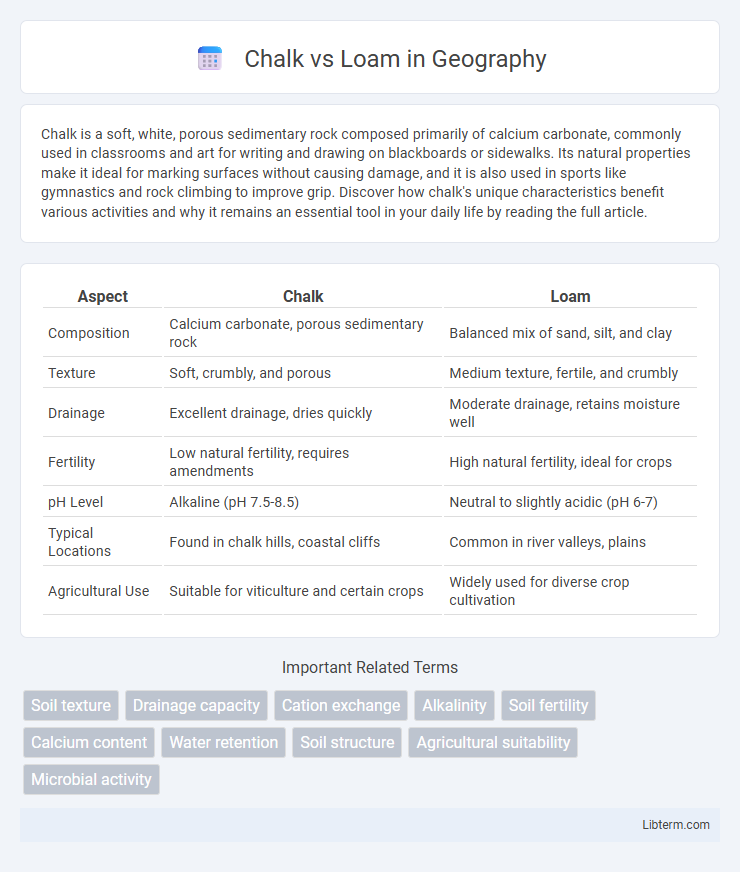Chalk is a soft, white, porous sedimentary rock composed primarily of calcium carbonate, commonly used in classrooms and art for writing and drawing on blackboards or sidewalks. Its natural properties make it ideal for marking surfaces without causing damage, and it is also used in sports like gymnastics and rock climbing to improve grip. Discover how chalk's unique characteristics benefit various activities and why it remains an essential tool in your daily life by reading the full article.
Table of Comparison
| Aspect | Chalk | Loam |
|---|---|---|
| Composition | Calcium carbonate, porous sedimentary rock | Balanced mix of sand, silt, and clay |
| Texture | Soft, crumbly, and porous | Medium texture, fertile, and crumbly |
| Drainage | Excellent drainage, dries quickly | Moderate drainage, retains moisture well |
| Fertility | Low natural fertility, requires amendments | High natural fertility, ideal for crops |
| pH Level | Alkaline (pH 7.5-8.5) | Neutral to slightly acidic (pH 6-7) |
| Typical Locations | Found in chalk hills, coastal cliffs | Common in river valleys, plains |
| Agricultural Use | Suitable for viticulture and certain crops | Widely used for diverse crop cultivation |
Introduction to Chalk and Loam Soils
Chalk soil, characterized by its alkaline pH and high calcium carbonate content, promotes excellent drainage but can challenge nutrient retention for plants. Loam soil offers an ideal agricultural medium, combining sand, silt, and clay in balanced proportions, which ensures optimal moisture retention and fertility. Understanding these soil types is crucial for selecting appropriate crops and managing soil health effectively.
Defining Chalk Soil: Key Characteristics
Chalk soil is a type of alkaline soil characterized by its high calcium carbonate content, resulting in a pH typically above 7.5 and excellent drainage due to its porous, crumbly texture. It tends to be shallow and nutrient-poor, often causing challenges for moisture retention and nutrient availability for plants. Chalk soil supports specific vegetation adapted to alkaline conditions, such as certain grasses, wildflowers, and drought-resistant crops.
Loam Soil Overview: Structure and Composition
Loam soil is a balanced mixture of sand, silt, and clay, typically composed of 40% sand, 40% silt, and 20% clay, which provides optimal aeration, drainage, and nutrient retention. Its granular, crumbly structure enhances root penetration and water holding capacity, making it ideal for diverse agricultural and horticultural applications. The rich organic matter content in loam promotes microbial activity and soil fertility, supporting robust plant growth compared to chalky soils.
Nutrient Content Comparison: Chalk vs Loam
Loam soil contains higher levels of essential nutrients like nitrogen, phosphorus, and potassium compared to chalk soil, making it more fertile for plant growth. Chalk soil is alkaline and often lacks organic matter, resulting in lower nutrient availability and requiring amendments to support nutrient uptake. The balanced texture of loam also promotes better nutrient retention and root penetration than the coarse, calcareous structure of chalk soil.
Water Retention and Drainage Abilities
Chalk soil features high drainage capabilities due to its coarse texture and alkaline nature, which allows water to pass through quickly but limits water retention. Loam soil balances water retention and drainage effectively, combining sand, silt, and clay particles to hold moisture while preventing waterlogging. For gardening or agriculture, loam supports consistent water availability, whereas chalk soil requires supplemental irrigation to maintain adequate moisture.
Impact on Plant Growth and Crop Yield
Chalk soils, characterized by high calcium carbonate content and alkaline pH, often limit nutrient availability such as iron and phosphorus, negatively impacting plant growth and reducing crop yield. Loam soils, with balanced proportions of sand, silt, and clay, provide optimal aeration, moisture retention, and nutrient accessibility, promoting robust root development and higher agricultural productivity. Crop yield in loam soils consistently outperforms chalk soils due to better water holding capacity and nutrient bioavailability essential for healthy plant growth.
Best Plants for Chalk and Loam Soils
Chalk soils are alkaline, well-draining, and low in nutrients, ideal for plants like lavender, clematis, and beech trees that thrive in calcium-rich conditions. Loam soils are balanced with sand, silt, and clay, offering excellent fertility and moisture retention, perfect for vegetables, roses, and fruit trees. Selecting plants compatible with chalk or loam soil pH and texture ensures optimal growth and health in garden landscapes.
Soil Management Techniques for Each Type
Chalk soils, characterized by high pH and good drainage, require careful management with the addition of organic matter and mulches to improve moisture retention and nutrient availability. Loam soils, known for their balanced texture and fertility, benefit from regular aeration and the incorporation of compost to maintain structure and enhance microbial activity. Employing crop rotation and targeted fertilization tailored to the soil type optimizes plant growth and soil health for both chalk and loam environments.
Pros and Cons: Chalk vs Loam
Chalk soil offers excellent drainage and warmth, promoting early growth, yet its high alkalinity can limit nutrient availability and may require lime amendments. Loam soil provides a balanced mixture of sand, silt, and clay, ensuring optimal moisture retention, nutrient content, and aeration, but can be prone to compaction if not properly managed. Choosing between chalk and loam depends on crop tolerance to pH levels and drainage needs, impacting overall plant health and productivity.
Choosing the Right Soil for Your Garden
Loam soil offers a balanced mix of sand, silt, and clay, providing excellent drainage and nutrient retention ideal for most garden plants, while chalk soil is alkaline with high calcium carbonate content, favoring plants adapted to alkaline conditions such as lavender and clematis. Understanding the pH level and texture differences between chalk and loam helps gardeners select soil that supports optimal root growth and nutrient uptake. Testing your garden soil before planting ensures you adjust for pH and nutrient requirements, creating the best environment for your specific crops or flowers.
Chalk Infographic

 libterm.com
libterm.com